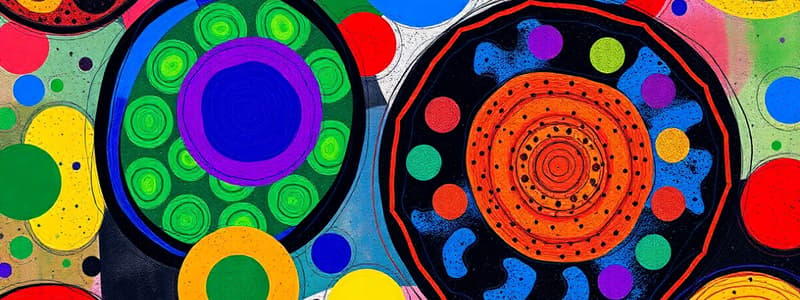Podcast
Questions and Answers
What is a key characteristic that distinguishes prokaryotic cells from eukaryotic cells?
What is a key characteristic that distinguishes prokaryotic cells from eukaryotic cells?
- Prokaryotic cells are generally larger and more complex.
- Prokaryotic cells lack a nucleus and have circular DNA. (correct)
- Prokaryotic cells have linear DNA organized into chromosomes.
- Prokaryotic cells have membrane-bound organelles.
Which organelle is primarily responsible for energy production in a cell?
Which organelle is primarily responsible for energy production in a cell?
- Endoplasmic Reticulum
- Chloroplast
- Mitochondria (correct)
- Golgi Apparatus
Which phase is NOT part of mitosis?
Which phase is NOT part of mitosis?
- Metaphase
- Telophase
- Prophase
- Interphase (correct)
What is the purpose of the smooth endoplasmic reticulum (ER)?
What is the purpose of the smooth endoplasmic reticulum (ER)?
Which process describes the movement of substances across a cell membrane without the use of energy?
Which process describes the movement of substances across a cell membrane without the use of energy?
During meiosis, how many genetically distinct daughter cells are produced?
During meiosis, how many genetically distinct daughter cells are produced?
What role do receptors on cell membranes play in cellular communication?
What role do receptors on cell membranes play in cellular communication?
Which of the following statements regarding cellular metabolism is true?
Which of the following statements regarding cellular metabolism is true?
Which cell structure is responsible for modifying, sorting, and packaging proteins and lipids?
Which cell structure is responsible for modifying, sorting, and packaging proteins and lipids?
In which type of cell would you find chloroplasts?
In which type of cell would you find chloroplasts?
Flashcards are hidden until you start studying
Study Notes
Overview of Cells
- Cells are the basic unit of life, serving as fundamental building blocks of all living organisms.
- There are two main cell types: prokaryotic and eukaryotic.
Prokaryotic Cells
- Characterized by the absence of a nucleus and membrane-bound organelles.
- Generally smaller and simpler than eukaryotic cells.
- DNA is circular and found in a region called the nucleoid.
- Common examples include Bacteria and Archaea.
Eukaryotic Cells
- They are distinguished by the presence of a nucleus and membrane-bound organelles.
- Typically larger and more complex compared to prokaryotic cells.
- DNA is linear and organized into chromosomes.
- Examples encompass animal cells, plant cells, fungal cells, and protists.
Cell Structure
- Cell Membrane:
- Composed of a phospholipid bilayer; it regulates the flow of substances in and out.
- Cytoplasm:
- A gel-like substance where various cellular processes take place.
- Nucleus:
- It houses genetic material (DNA) and governs cell activities.
- Ribosomes:
- Sites for protein synthesis within the cell.
- Endoplasmic Reticulum (ER):
- Rough ER, adorned with ribosomes, is responsible for protein synthesis; Smooth ER synthesizes lipids.
- Golgi Apparatus:
- Modifies, sorts, and packages proteins and lipids for secretion or delivery to other locations.
- Mitochondria:
- Known as the powerhouse of the cell; site of ATP production through cellular respiration.
- Chloroplasts (specific to plant cells):
- Conduct photosynthesis and contain chlorophyll, which captures sunlight.
Cell Division
- Mitosis:
- A type of somatic cell division that yields two identical daughter cells; includes phases such as Prophase, Metaphase, Anaphase, and Telophase.
- Meiosis:
- Responsible for gamete formation, resulting in four genetically distinct daughter cells; involves two rounds of division termed Meiosis I and Meiosis II.
Cell Metabolism
- Catabolism:
- The metabolic process that breaks down molecules to release energy.
- Anabolism:
- The synthesis of compounds, which requires an input of energy.
Cellular Communication
- Cells utilize chemical signals like hormones and neurotransmitters to communicate.
- Receptors located on cell membranes play a pivotal role in detecting these signals and initiating cellular responses.
Cellular Transport
- Passive Transport:
- Refers to the movement of substances across cell membranes without the need for energy, including processes like diffusion and osmosis.
- Active Transport:
- Requires the expenditure of energy to move substances against their concentration gradients, exemplified by mechanisms such as the sodium-potassium pump.
Importance of Cells
- Cells serve as the foundation for all biological processes.
- The diversity of cell types enables specialization and the emergence of complex functions in multicellular organisms.
Studying That Suits You
Use AI to generate personalized quizzes and flashcards to suit your learning preferences.




